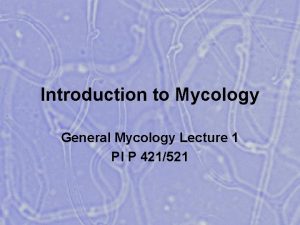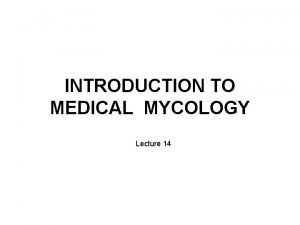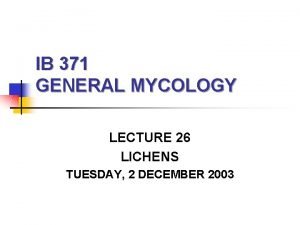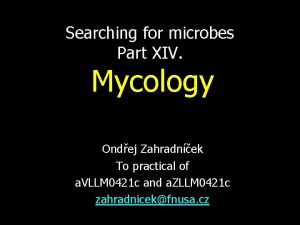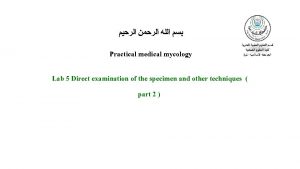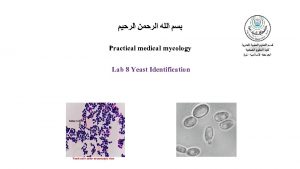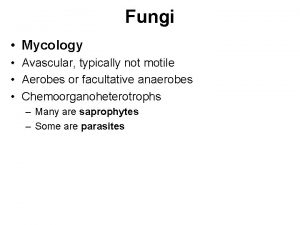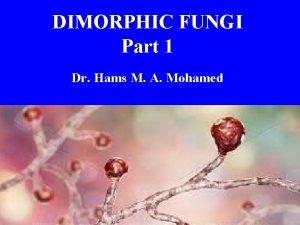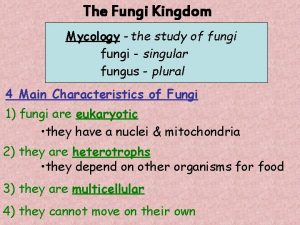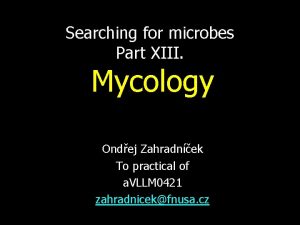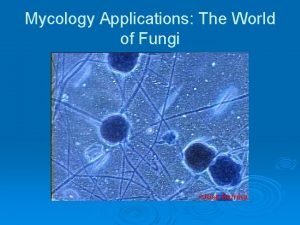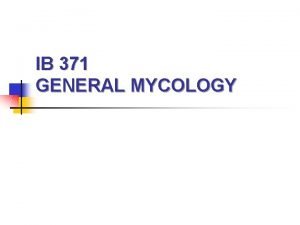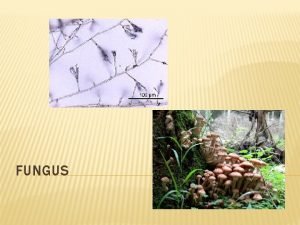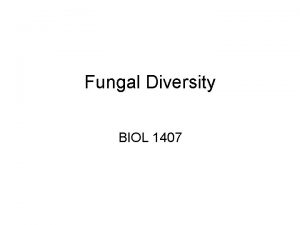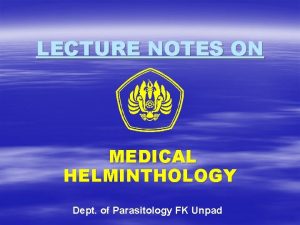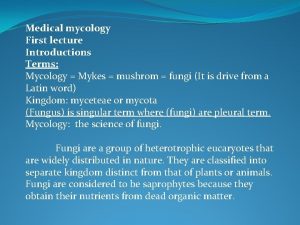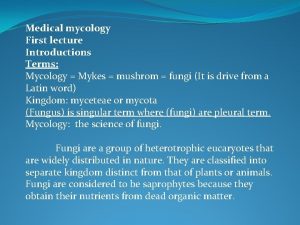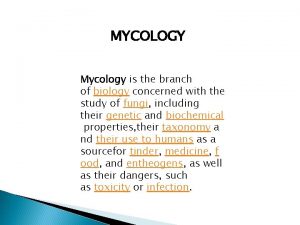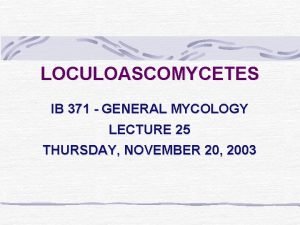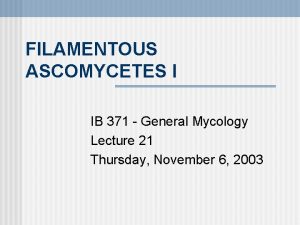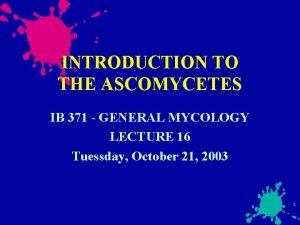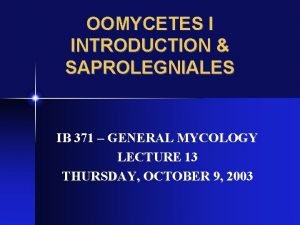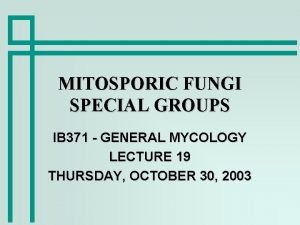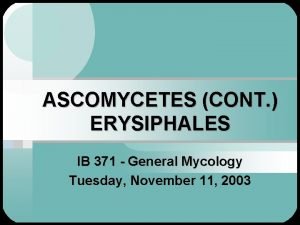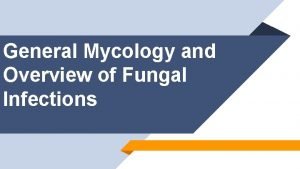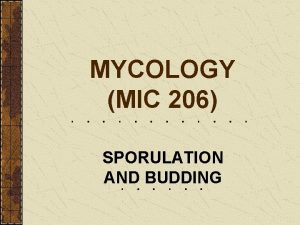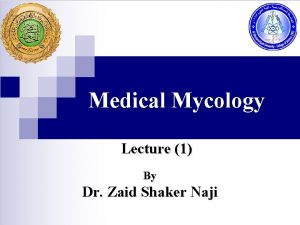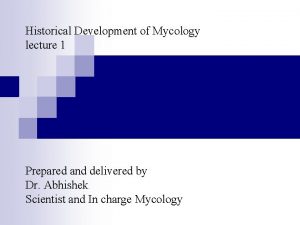Introduction to Mycology General Mycology Lecture 1 Pl




























- Slides: 28

Introduction to Mycology General Mycology Lecture 1 Pl P 421/521

What is a fungus? • A eukaryotic, heterotrophic organism devoid of chlorophyll that obtains its nutrients by absorption, and reproduces by spores. • The primary carbohydrate storage product of fungi is glycogen. • Most fungi have a thallus composed of hyphae (sing. hypha) that elongate by tip growth

Fungal hyphae form a network called a mycelium (pl. mycelia)

• Carl Linnaeus (1707 -1778) the “Father of Taxonomy” – “ Minerals exist; plants exist and live; animals exist, live and sense. ” – Plants without obvious sexual organs were classified in Class Cryptogamia (lichens, fungi, mosses, ferns) • Fungi are primitive plants under this classification of organisms.

R. H. Whittaker’s 1969 Classification

Modern Classification • At least 7 kingdoms are now recognized: – Eubacteria, Archaebacteria, Animalia, Plantae, Eumycota, Stramenopila (Chromista), Protoctista (Protozoa, Protista)


Fungi versus fungi • “fungus” is used inclusively for a heterogenous group of organisms that have traditionally been studied by mycologists • “Fungi” refers to the organisms in the Kingdom Fungi, the true fungi, also called the “Eumycota”

Kingdom Fungi Phyla: Chytridiomycota Zygomycota Glomeromycota Ascomycota (inc. Deuteromycetes) Basidiomycota

Glomeromycota

Kingdom Stramenopila (Chromista) Phyla: Oomycota Hyphochytriomycota Labyrinthulomycota Protists (Protoctists) Phyla: Plasmodiophoromycota Dictyosteliomycota Acrasiomycota Myxomycota

Hierarchical Classification Kingdom Fungi Phylum Basidiomycota Class Basidiomycetes Order Agaricales Family Agaricaceae Genus Agaricus Species: Agaricus campestris L.

Agaricus campestris L. • Agaricus is the genus • campestris is the specific epithet • The genus + species is the Latin binomial; note that the genus and species are in italics (or underlined), the genus is capitalized and the species epithet is in lower case • L. stands for Linnaeus, the authority • Agaricus campestris is the type species of the genus

Agaricus bisporus (Lange) Imbach • Lange first described this fungus as Coprinus bisporus • Imbach later transferred the species to Agaricus

Nomenclature • Nomenclature: the “allocation of scientific names to the units a systematist considers to merit formal recognition. ” (Hawksworth et al. , 1995. The Dictionary of the Fungi). • The nomenclature of fungi is governed by the International Code for Botanical Nomenclature, as adopted by the International Botanical Congress.

Typological Species Concept • "Species are as many as were created in the beginning by the Infinite. " (Linnaeus, 1758) • Each species represented by a type specimen, designated in the original description and deposited in a recognized collection (eg. , herbarium) • The name is tied to the type specimen • The type specimen is not necessarily typical of the entire species!

How are fungi named? • To determine the correct name for a taxon, certain steps must be followed, including: – Effective publication – Valid publication • Description or diagnosis in Latin • Clear indication of rank • Designated type

How many species of fungi exist? 80, 000 species of fungi described 1, 700 new species described each year

Estimating the number of fungal species • Hawksworth, D. L. (1991). The fungal dimension of biodiversity: magnitude, significance, and conservation. Mycological Research 95: 641 -655 • Hawksworth, D. L. (2001) The magnitude of fungal diversity: the 1. 5 million species estimate revisited. Mycological Research 105 (12): 1422 -1432.


Fungi are ancient • Major fungal lineages are ancient, perhaps emerging one billion years ago • Fungi were present before the emergence of animals and vascular plants

Mass extinction at K-T boundary; fungal ‘spike’ Increasing diversity of angiosperms, mammals, birds Gymnosperms dominant, evolution of angiosperms; first birds Gymnosperms become dominant, first dinosaurs, first mammals Mass extinction of ~95% of all species; fungal ‘spike’ Origin of insects, ferns, seed plants Earliest terrestrial vascular plants marine animals diversify; first appearance of most animal phyla; diverse algae Modified from Blackwell, 2001

Associations • Fungi form symbiotic relationships with a number of organisms: – Lichens – Mycorrhizas – Endophytes

Decomposers • As saprotrophs, particularly as decomposers, fungi are essential components of the carbon cycle and are among the few organisms that can break down lignin

Pathogens • Fungi are important as pathogens of animals and plants. – Over 70% of all plant diseases are caused by fungi



 Introduction to mycology
Introduction to mycology Scotch tape preparation for fungi
Scotch tape preparation for fungi Mycology lecture
Mycology lecture 01:640:244 lecture notes - lecture 15: plat, idah, farad
01:640:244 lecture notes - lecture 15: plat, idah, farad Mycology
Mycology Tease mount preparation
Tease mount preparation Tinea vericolor
Tinea vericolor Candida albicans germ tube test
Candida albicans germ tube test Mycology test
Mycology test Is yeast multicellular or unicellular
Is yeast multicellular or unicellular Mycology
Mycology Dimorphic fungi examples
Dimorphic fungi examples Mycology
Mycology Mycology
Mycology Industrial mycology
Industrial mycology Mycology
Mycology Lichen as food
Lichen as food Mycology is the study of
Mycology is the study of Glomerulomycota
Glomerulomycota Helminthology notes
Helminthology notes General medicine lecture
General medicine lecture General parasitology lecture notes
General parasitology lecture notes Introduction to biochemistry lecture notes
Introduction to biochemistry lecture notes Introduction to psychology lecture
Introduction to psychology lecture Introduction to algorithms lecture notes
Introduction to algorithms lecture notes Planos en cinematografia
Planos en cinematografia Where did general lee surrender to general grant?
Where did general lee surrender to general grant? Introduction to general phonetics and phonology
Introduction to general phonetics and phonology Car insurab
Car insurab
